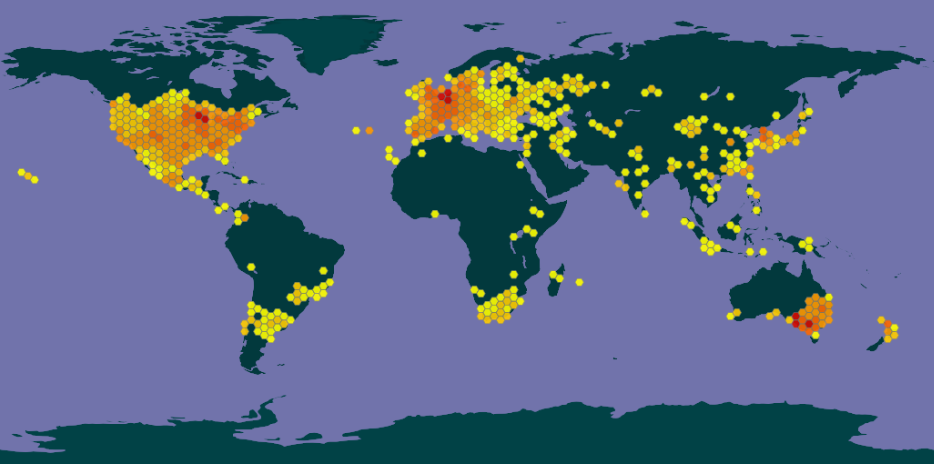The Case of the Aquatic Vermin aka Carp
The Misplaced
The common carp is a fresh water fish species. Scientifically, known as Cyprinus carpio, it is one of many fish in the genus Cyprinus. Please note that not all members of this genus have the same sorry story as C. carpio.
As the title of the case study suggests, C. carpio is regarded in some areas as a serious pest, sometimes referred to as the fish version of a cane toad. Common carp are native to Eurasia but have been widely introduced and are now found worldwide except for the poles and northern Asia.
Description
Carp are characterized by their deep bodies and their serrated dorsal fins. Their body plan includes a forked caudal fin, plus anal, pectoral and pelvic fins.
They can grow to 100 to 120 cm long, but the usual size range is 30-50 cm. Usual weights vary from 1 to 4 kg, but may reach up to 50 kg in some instances.
The lips are thick and may be extended out to form a tube.
Colours and scale patterns show some variation, depending on subspecies.
Ecology and Feeding
According to The Department of Primary Industries, NSW, Australia
Carp are usually found in still or slowly flowing waters at low altitudes, especially in areas where there is abundant aquatic vegetation. They are also found in brackish lower reaches of some rivers and coastal lakes.
They are capable of tolerating a range of environmental conditions. They have a greater tolerance of low oxygen levels, pollutants and turbidity than most native fish, and are often associated with degraded habitats, including stagnant waters.((General information about carp))
Carp are usually bottom feeders. They feed by sucking up mud from the bottom, ejecting it, and then selectively consuming items while they are suspended in the water. Also, these fish possess a ‘carp stone’, a horned surface on the roof of the mouth, which enables them to grind food particles down to more suitable sizes.
Barbel pairs (see image above) are found around the mouth of many carp and they house sensory organs which are used to search for food in murky water. This gives the carp an advantage over other fish which are effectively blind in this environment.
Carp are omnivores; and they will feed on what is available in their environment at any given time. Typical food sources are listed in table below.
| Animal | Plant |
|---|---|
| fish | leaves |
| carrion | roots |
| insects | tubers |
| molluscs | seeds |
| worms | nuts |
| aquatic crustraceans | algae |
| zooplankton | macroalgae |
Carp are vulnerable to predation when juvenile. They are eaten by large carnivorous fish and predatory water birds.
Reproduction
Carp breeding time is determined by both water temperature and the concentration of ions in the water. This means there may be several breeding seasons in a year. When ready to lay eggs, females gather in shallow water, and release around 300,000 eggs at a time. Males fertilise the eggs externally and then the females agitate the water to facilitate the fertilised eggs sticking to surrounding aquatic vegetation. This gives improves the chances of survival of the offspring, compared to sinking to the muddy bottom of the body of water. This is the only parental care for the offspring. In about 3 to 4 days, the fertilized eggs develop into fry about 5 mm long.
C. carpio males mature at about 2 to 5 years, females 3 to 5 years.
The longest reported life span of C. carpio is 38 years in the wild with an average of about 20 years.
The Displaced
How carp displace other species and disrupt ecosystems
C. carpio is the third most frequently introduced species world-wide. On every region where it has been introduced, it has reduced water quality and disrupted aquatic habitats.
- In shallow aquatic ecosystems, common carp can be considered “ecosystem engineers” or “keystone modifiers” in that they have strong effects on benthic communities.
- Aquatic macrophytes are integral to ecosystem functioning. Carp are known to damage aquatic macrophytes by eating them and uprooting them. This disrupts the species that rely on these plants for life, and poses a threat to wetlands that are used by many fish as spawning and nursery habitats. The loss of rooted macrophytes due to carp activity is intuitively likely to lead to a decline in biological diversity, in endemic fish, amphibians, and invertebrates.
- Carp are also believed to stimulate algal bloom formation by increasing nutrient release from sediments; they do this in two ways: by sediment resuspension during feeding and by excretion. They also decrease algal grazing by water fleas (which the juvenile carp prey upon).
The introduction of carp into non-native ecosystems means that the carp are living/breeding in regions without the predators and the pathogens that keep their numbers in check.
Changes to water flows, declining water quality and other changes to river habitats over the past few decades have negatively affected many native fish while favouring carp.
Example: From research on lake in UTAH, USA (UTAH LAKE RESEARCH 2016 Progress Report)
Prior to European settlement and shortly thereafter, Utah Lake’s food web was dominated by the top down predator, the Bonneville cutthroat trout and twelve other fish species. Equally as important as the top down predators in the food web were Utah Lake’s bottom up controllers, mollusks. There were an unprecedented seventeen mollusk taxa in Utah Lake prior to settlement, including at least two major water quality regulator mussel taxa.
It is thought that carp now make up 90% of the biomass of the lake.
Example: from Koehn JD (2004). Carp (Cyprinus carpio) as a powerful invader in Australian waterways. Freshwater Biology 49: 882–894
The invasion of carp (Cyprinus carpio L.) in Australia illustrates how quickly an introduced fish species can spread and dominate fish communities. This species has become the most abundant large freshwater fish in south-east Australia, now distributed over more than 1,000,ooo km2.
The Consequences
Where is the invasion?

Remediation and prevention
Potential carp control techniques include
- harvesting - in many countries, people enjoy eating carp. It is a tradition in some regions. Also marketing extols carp flesh as a rich source of omega-3 fatty acids, lean proteins, vitamins, and essential minerals. Carp is deliberately farmed in some parts of the world. Total world aquaculture production of Cyprinus carpio was nearly 4.2 million tonnes in 2018. Common carp are also harvested as the main ingredients for some fertiliser brands, and also used in the manufacture of livestock feeds.
- exclusion with screens or barriers - acoustic barriers, bubble barriers, mechanical barriers have been used to stop the geographical spread of carp
- poisoning - Rotenone is a non-selective natural chemical that is relatively safe and has been used with some success in the USA
- biological control - In countries where the carp problem is acute, biocontrol measures to reduce the carp population have been investigated.
For example
1. The use of a herpes virus (see https://pestsmart.org.au/toolkit-resource/frequently-asked-questions-about-the-carp-herpesvirus-cyhv-3/)
2. The daughterless carp project ( see https://pestsmart.org.au/toolkit-resource/overview-of-daughterless-carp-research/)

Koi (or Japanese) carp are domesticated ornamental varieties of common carp and show a much broader range of colours and colour patterns, with various combinations of white, black, red, yellow, blue and orange markings.
Dig Deeper
- Global invasive species database - Cyprinus carpio
- Richards, D. C. and T. Miller. 2017. A preliminary analysis of Utah Lake’s unique foodweb with a focus on the role of nutrients, phytoplankton, zooplankton, and benthic invertebrates on HABs. Utah Lake Research 2016. Progress Report. Wasatch Front Water Quality Council, Salt Lake City, UT.
- Koehn JD (2004). Carp (Cyprinus carpio) as a powerful invader in Australian waterways. Freshwater Biology 49: 882–894 https://onlinelibrary.wiley.com/doi/full/10.1111/j.1365-2427.2004.01232.x
- Finterest
- Common Carp Management Using Biocontrol and Toxins
- Fishers catch up to 18,000 carp as flooded Murray-Darling Basin sees population boom
- Carp in Australian Rivers: Problems and potential solutions
- Fishing as a carp control method















